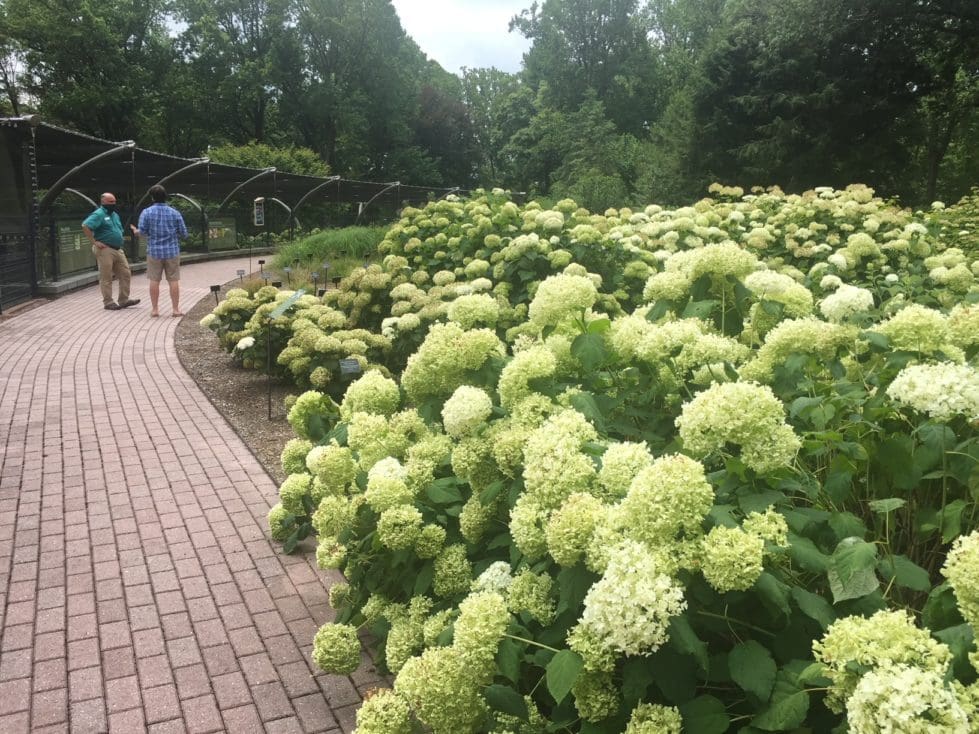If you want to choose a native hydrangea that will attract pollinators, all you have to do is follow the buzzing.
When Mt. Cuba Garden Center was studying 29 species and cultivars of native hydrangeas, the row filled with lacecap hydrangeas — particularly Hydrangea arborescens ‘Haas’ Halo’ — looked (and sounded like) like an insect version of the Starboard on Memorial Day weekend.
Buzz, buzz, buzz as the bees flitted around gorging themselves on the lacecap nectar, ignoring nearby plants that were baking in the sun on that July day.
The lacecaps were planted across the row from mophead hydrangeas, known for their giant balls of flowers. Lacecaps have hundreds of tiny flowers in the center, surrounded by showy white flowers on the outer ring.
“You could walk down that row and once you got down to the lace caps, it was this auditory experience, where you’re just hearing and seeing hundreds of 1,000s of insect pollinators all at once,” said Sam Hoadley, manager of horticultural research. “It was it’s really quite striking and incredible to witness.”
It’s one of the many details including in Mt. Cuba’s newest trial garden research report, “Wild Hydrangea for the Mid-Atlantic Region.”
The hydrangea study is the latest in a series that looks at popular plants to see which grow best in the Mid-Atlantic region and which attract the most pollinators. The topics have included echinacea, Helenium, phlox, monarda, baptisia, coreopsis, heuchera and asters.

When Mt. Cuba is open, visitors can walk through the trial garden and see how the plants are doing. Photo by Betsy Price
The reports detail which of the plants grow the best and offers advice on how gardeners can best care for the plants to get the effects they want to achieve.
As far as the hydrangeas go, Hoadley said the study showed there are lots of excellent choices, whether you want to attract pollinators or simply want a pink ornamental plant. Mt. Cuba found excellent specimens for sun and shade, and in both lacecap and mophead.
A former du Pont estate, Mt. Cuba focuses on native plants, which support local wildlife and better handle weather extremes such as droughts and unusual wet seasons than non-natives do. The studies are meant to help inform both the home gardener and the nursery industry.
“Hydrangea arborescens are a classic landscape shrub that is currently undergoing a garden renaissance,” said Hoadley about the lacecaps. “Their beauty, cultural adaptability and ability to support wildlife make them a welcome addition to any garden in the mid-Atlantic region and beyond.”
Among the key takeaways offered by the report:
- While the iconic favorites come in lacecap and mophead varieties, pollinators clearly — and loudly — prefer lacecap hydrangeas, particularly Hydrangea arborescens ‘Haas’ Halo.’
- Hydrangeas do better in shade when grown in the Mid-Atlantic region. The evaluation was conducted in full sun, and 19 plants were also grown in 60 percent shade for comparison.
- Cutting back plants often reduces the overall height and width of the shrub while increasing the diameter of the flower heads.
The hydrangeas are popular enough that plant breeders continue to introduce new versions, called cultivars, to enhance desired traits such as sturdy stems and new flower forms and colors. Those new versions made plant experts wonder about their ability to perform and to support wildlife.
“There’s several species that we wanted to trial, specifically because they’re very close related,” said Hoadley.
What makes the bees get busy on lacecaps is that the vast number of fertile flowers, he said. Some of the mopheads, he said, were beautiful and grew well, but the blooms were sterile and didn’t attract bees.
While the lacecaps in general drew more bees, one of its cultivars, Hydrangea arborescens ribbon lace, did not, he pointed out.
One reason that Mt. Cuba recommended shade or part shade is because when ornamental plants flowered withered in heat, they turned brown and unattractive. That doesn’t happen in the shade, Hoadley said.
He pointed out that there were several varieties of pink native hydrangeas that did do well in sun, including Hydrangea arborescens ‘NCHA4’ (Incrediball Blush).
All the trial garden reports can be read online, and hard copies of some can be picked up at the gardens when the center reopens in April.
The study chose these plants as their top nine choices:
- Hydrangea arborescens ‘Haas’ Halo’
- Hydrangea arborescens ‘SMNHALR’ (Lime Rickey®)
- Hydrangea arborescens ‘NCHA2’ (Invincibelle® Spirit II)
- Hydrangea arborescens ‘NCHA4’ (Incrediball® Blush)
- Hydrangea arborescens ‘Abetwo’ (Incrediball®)
- Hydrangea arborescens ‘Bounty’
- Hydrangea arborescens ‘Dardom’ (White Dome®)
- Hydrangea arborescens ‘Total Eclipse’
- Hydrangea arborescens ‘Mary Nell’
Share this Post





